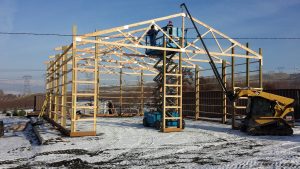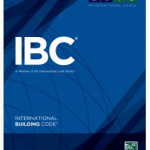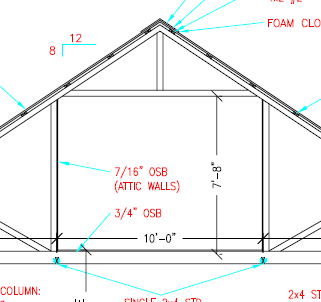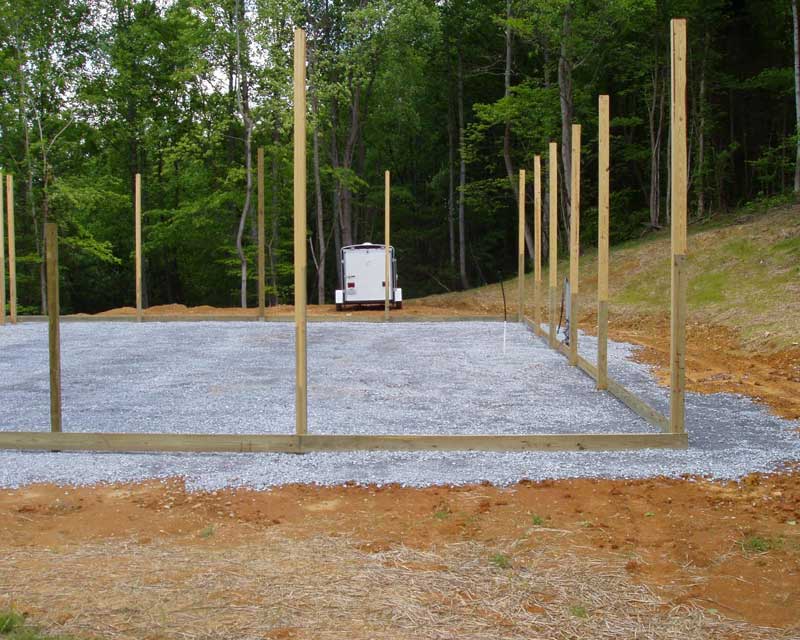In order to follow the deflection criteria of the International Building Codes, other than for fairly small wall column spacings with low wind speeds, pole building wall girts need to be installed in a “bookshelf” fashion.
What even is “deflection criteria”?
Dictionary.com defines deflection as, “the deviation of the indicator of an instrument from the position taken as zero.”
In layperson’s terms, when you push on something with a known force, how far does it bend (or deflect)?
 Prior to the adoption of the International Building Codes, wall members which did not support a brittle finish material (e.g. drywall), were not limited in how far they could deflect.
Prior to the adoption of the International Building Codes, wall members which did not support a brittle finish material (e.g. drywall), were not limited in how far they could deflect.
Not so with the new code.
For those of you who care to look it up and read along, Table 1604.3 lists deflection limits. For walls with brittle finishes, the limitation is L/240 (where “L” is the span or length of the supporting member). For flexible finishes, the limit is L/120. Footnote A includes, “For secondary wall members supporting formed metal siding, the design wind load deflection shall not exceed L/90.”
The smaller the value L is divided by, the larger the allowable deflection is.
Ignoring the width of nominal six inch building columns the allowable deflection of wall girts for an 8’ bay (with steel siding) would be 1”; a 10’ bay 1.27”; 12’ bay 1.54”.
Using the least possible loads allowed by code – which would be 85 mile per hour winds, B wind exposure and a building Occupancy class of I (I = a building which represents a low hazard to human life in the event of failure) combined with the stiffest possible commonly used lumber (Douglas Fir or Southern Yellow Pine #2) and spaced 24 inches on center, some problems occur.
Using 2×6 lumber on 10’ bays the actual deflection is 1.507” and on 12’ bays 3.226”. On 8’ bays IF 2×4 #2 is actually used (it is rarely available in lumber yards), then it would deflect 0.924” and be OK. Another issue with the 2×4 girts on 8’ bays, is this style of construction is most prevalent in areas where the minimum wind speed is 90 mph.
Keeping all variables the same, except increasing the wind speed to 90 mph, increases the deflection of a 2×4 #2 to over an inch on an eight foot bay!
Shopping for your new ideal dream pole building? If so, ask specifically how the wall girts are placed. Anything other than “bookshelf” style pretty much guarantees the building being proposed, is not code conforming!










Seems most Pole building Companies consider the “bookshelf” method as “commercial style girt”. Though lateral strength is greater, aren’t they prone to sagging over time, possibly pulling the metal with it? When placed flat against the main post attachment is much easier, nailed through the face. In the bookshelf method attachment can be A. Toe-nailed “not a fan of this”, B. some form of metal clip which is time consuming, or C. flat blocked with 2×6 against post with girt nailed through top to the block, also labor intensive and more material used.
I think bookshelf method would aid the finishing of the interior space also gives a bay for batt insulation. Also being flat “bookshelf” would help keep posts from twisting. Other than deflection do you find one method structurally superior, and which wins in cost savings? Just my thoughts on the subject.
Jeff ~
Thank you for your comments. In some parts of the country “bookshelf” girts would also be known as “commercial style girts”. When ANSI/ASABE S618 “Post Frame Building Nomenclature” was published in December 2010, the term “bookshelf” was officially recognized as the term to be used industry wide.
The siding (whether steel or wood sheathing) is more than rigid enough to restrain the girts from sagging. In over 14,000 buildings, I have never had sagging of bookshelf style girts been reported as an issue.
As to installation methods, toe nailing would be considered a poor application, metal hangers are not designed for possible upward or downward loads which could be applied during construction, leaving solid end blocking as the viable alternative. Considering the blocking can all be precut to length at one time, eliminating measuring once the first row of girts is in place, it is really no more time consuming than placing girts flat on the outside face of the columns (which in most instances would not be code conforming, and therefore not an option).
Bookshelf girts will provide for an insulation cavity, and if properly sized can be used to install a flat interior surface material (such as drywall or sheathing).
If the consideration is code conformance, by the time flat on the outside of the column girts are spaced close enough to met code limitations for deflection (and in many cases bending), the bookshelf method is going to be less expensive, stiffer against bending (deflection) and stronger in resisting wind loads.
Here in the mid-west, we use a “L”, 1 – 2x on edge fastened to the outside of the posts & one laid flat which is fastened to the top with screws/nails. The top 2x is frequently referred to as a “rat run”. This arrangement addresses both sagging & deflection concerns.
Depending upon the size and grade of the two members, the distance between columns, spacing of the girts, wind speed and exposure, this is certainly a viable option in many cases. With the members being 2×4, the combined Sm (Section Modulus) of the two members is only 4.375, compared to a single 2×6 laid flat like a shelf which would be 7.5625. As most 2x4s are graded std&btr, which has a very low Fb (fiber strength in bending) compared to a 2×6 – the 2×6 is going to be stiffer, take less material and less labor to install.
Why not run the corrugated metal siding horizontally directly fastened to the posts and eliminate the girts? I would be willing to space posts closer, especially at load bearing walls.
In order to adequately transfer shear loads, posts would probably need to be placed every 2-3′ (depending of course upon design wind speed and exposure as well as dimensions of building). There are also other challenges associated with running wall steel horizontally.